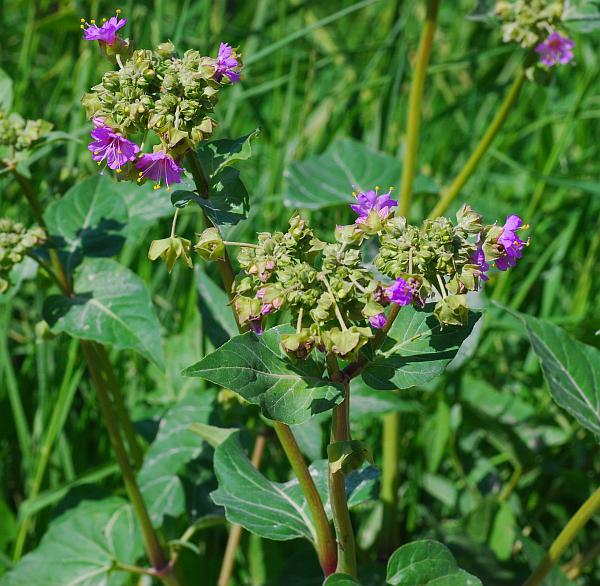Mirabilis nyctaginea (Michx.) MacMill.
Wild Four-O'Clock

Native
CC = 0
CW = 3
MOC = 65
© SRTurner
Mirabilis nyctaginea (Michx.) MacMill.Wild Four-O'Clock | |
 |
Native CC = 0 CW = 3 MOC = 65 |
© SRTurner |
|
Family - Nyctaginaceae Habit - Perennial forb with woody roots and sometimes a woody base. Stems - Ascending to erect, to 1.2 m, dichotomously branching, sometimes multiple from the base, somewhat 4-angled, glabrous or sparsely hairy, sometimes slightly glaucous.
Leaves - Opposite, simple, petiolate. Main leaf petioles 1-5 cm long. Leaf blades 3-15 cm long, oblong-ovate to triangular-ovate, broadly rounded to more commonly truncate or cordate at the base, narrowed or abruptly tapered to a bluntly or sharply pointed tip, glabrous or nearly so. Margins with some cilia or a few strigose hairs.
Inflorescence - Dense terminal clusters of 3-6 flowers subtended by involucres, these broadly bell-shaped, 5-lobed, 5-6 mm long at flowering, becoming enlarged to 10-15 mm long at fruiting, glabrous or sparsely hairy on the surfaces, densely hairy along the margins, with 3-6 flowers. Pedicels to 1.5 cm.
Flowers - Perianth 8-10 mm long, pink to reddish purple. Petals absent. Stamens 3-5. Pistil 1 per flower, the ovary superior but appearing inferior because of the closely enveloping perianth tube, consisting of 1 carpel, with 1 locule, the placentation basal. Style 1, the stigma globose or disclike.
Fruits - Achenes 4-6 mm long (including the hardened perianth tube), densely hairy and roughened or finely warty on the sides and ribs, grayish brown to less commonly nearly black.
Flowering - May - October. Habitat - Upland prairies, streambanks, pastures, fields, roadsides, railroads, and disturbed areas. Origin - Native to the U.S. Lookalikes - None. Other info. - This species occurs throughout Missouri. It is common across the north-central portion of the continental U.S., becoming scattered in the northeast and uncommon or absent elsewhere. The common term "four o'clock" refers to the tendency of many plants in this family to open their flowers in late afternoon. The flowers typically wither and drop early the next morning. Because of this, it is uncommon to find plants in full, open bloom, and the images above are somewhat atypical in this respect. More commonly the plants are seen in fruit, or with only small bits of the perianth visible as small patches of pink here and there. This, the distinctive involucres enclosing the flowers, and the broad opposite leaves make the plant relatively easy to identify. Photographs taken in Marquette, MI., 9-10-03 (DETenaglia); also in Augusta, St. Charles County, MO, 5-11-2010, along the Katy Trail near Marthasville, Warren County, MO, 5-29-2013, on a roadside west of Washington, Franklin County, MO, 9-22-2014, and at Route 66 State Park, St. Louis County, MO, 5-11-2015 (SRTurner). |